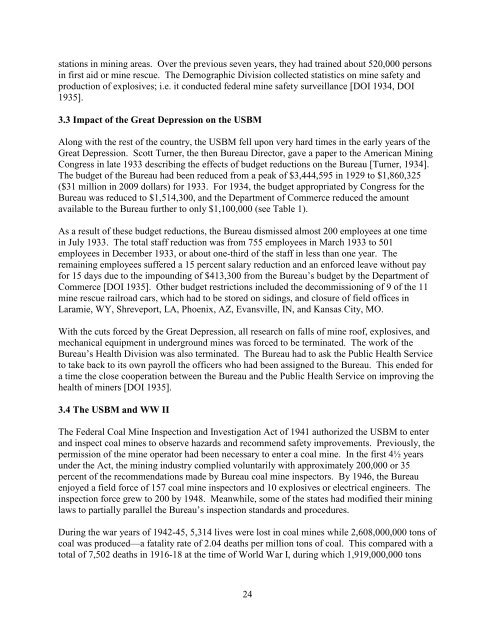One Hundred Years of Federal Mining Safety and Health Research
One Hundred Years of Federal Mining Safety and Health Research
One Hundred Years of Federal Mining Safety and Health Research
- No tags were found...
Create successful ePaper yourself
Turn your PDF publications into a flip-book with our unique Google optimized e-Paper software.
stations in mining areas. Over the previous seven years, they had trained about 520,000 persons<br />
in first aid or mine rescue. The Demographic Division collected statistics on mine safety <strong>and</strong><br />
production <strong>of</strong> explosives; i.e. it conducted federal mine safety surveillance [DOI 1934, DOI<br />
1935].<br />
3.3 Impact <strong>of</strong> the Great Depression on the USBM<br />
Along with the rest <strong>of</strong> the country, the USBM fell upon very hard times in the early years <strong>of</strong> the<br />
Great Depression. Scott Turner, the then Bureau Director, gave a paper to the American <strong>Mining</strong><br />
Congress in late 1933 describing the effects <strong>of</strong> budget reductions on the Bureau [Turner, 1934].<br />
The budget <strong>of</strong> the Bureau had been reduced from a peak <strong>of</strong> $3,444,595 in 1929 to $1,860,325<br />
($31 million in 2009 dollars) for 1933. For 1934, the budget appropriated by Congress for the<br />
Bureau was reduced to $1,514,300, <strong>and</strong> the Department <strong>of</strong> Commerce reduced the amount<br />
available to the Bureau further to only $1,100,000 (see Table 1).<br />
As a result <strong>of</strong> these budget reductions, the Bureau dismissed almost 200 employees at one time<br />
in July 1933. The total staff reduction was from 755 employees in March 1933 to 501<br />
employees in December 1933, or about one-third <strong>of</strong> the staff in less than one year. The<br />
remaining employees suffered a 15 percent salary reduction <strong>and</strong> an enforced leave without pay<br />
for 15 days due to the impounding <strong>of</strong> $413,300 from the Bureau’s budget by the Department <strong>of</strong><br />
Commerce [DOI 1935]. Other budget restrictions included the decommissioning <strong>of</strong> 9 <strong>of</strong> the 11<br />
mine rescue railroad cars, which had to be stored on sidings, <strong>and</strong> closure <strong>of</strong> field <strong>of</strong>fices in<br />
Laramie, WY, Shreveport, LA, Phoenix, AZ, Evansville, IN, <strong>and</strong> Kansas City, MO.<br />
With the cuts forced by the Great Depression, all research on falls <strong>of</strong> mine ro<strong>of</strong>, explosives, <strong>and</strong><br />
mechanical equipment in underground mines was forced to be terminated. The work <strong>of</strong> the<br />
Bureau’s <strong>Health</strong> Division was also terminated. The Bureau had to ask the Public <strong>Health</strong> Service<br />
to take back to its own payroll the <strong>of</strong>ficers who had been assigned to the Bureau. This ended for<br />
a time the close cooperation between the Bureau <strong>and</strong> the Public <strong>Health</strong> Service on improving the<br />
health <strong>of</strong> miners [DOI 1935].<br />
3.4 The USBM <strong>and</strong> WW II<br />
The <strong>Federal</strong> Coal Mine Inspection <strong>and</strong> Investigation Act <strong>of</strong> 1941 authorized the USBM to enter<br />
<strong>and</strong> inspect coal mines to observe hazards <strong>and</strong> recommend safety improvements. Previously, the<br />
permission <strong>of</strong> the mine operator had been necessary to enter a coal mine. In the first 4½ years<br />
under the Act, the mining industry complied voluntarily with approximately 200,000 or 35<br />
percent <strong>of</strong> the recommendations made by Bureau coal mine inspectors. By 1946, the Bureau<br />
enjoyed a field force <strong>of</strong> 157 coal mine inspectors <strong>and</strong> 10 explosives or electrical engineers. The<br />
inspection force grew to 200 by 1948. Meanwhile, some <strong>of</strong> the states had modified their mining<br />
laws to partially parallel the Bureau’s inspection st<strong>and</strong>ards <strong>and</strong> procedures.<br />
During the war years <strong>of</strong> 1942-45, 5,314 lives were lost in coal mines while 2,608,000,000 tons <strong>of</strong><br />
coal was produced—a fatality rate <strong>of</strong> 2.04 deaths per million tons <strong>of</strong> coal. This compared with a<br />
total <strong>of</strong> 7,502 deaths in 1916-18 at the time <strong>of</strong> World War I, during which 1,919,000,000 tons<br />
24
















